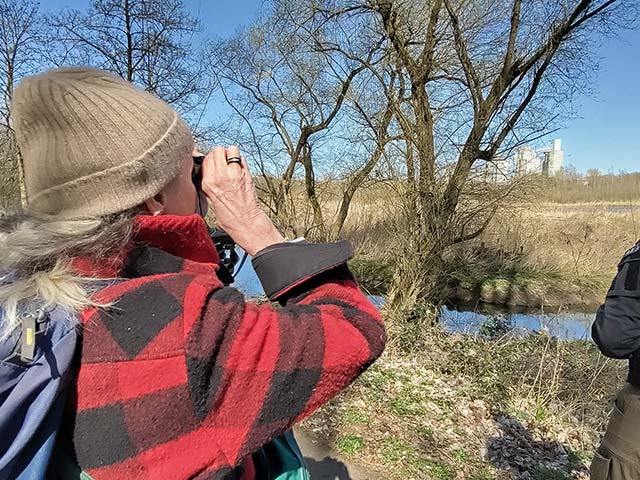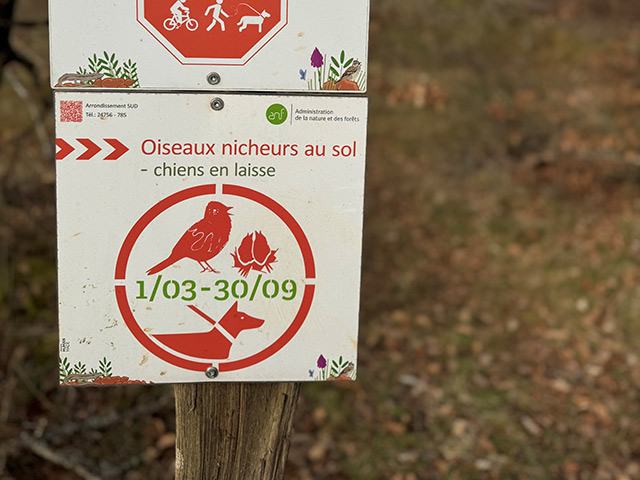On the last weekend of March, the bird life of the Minett UNESCO Biosphere was the focus of two workshops organised as part of our MiNELL – Minett Natur an Ënwelt LéierLab. Both workshops highlighted the positive impact of specific conservation actions on local biodiversity.
Schifflange Brill: A natural paradise for birds
On Saturday, a group of 15 people explored the wetlands of the Schifflange Brill in glorious weather, discovering its diverse birdlife.
After a brief welcome, the participants were informed about the scientific significance and process of bird ringing. They then had the opportunity to take part in a ringing session, observing and studying the characteristics of various bird species such as Dunnock (Prunella modularis), Blackcap (Sylvia atricapilla) and Greenfinch (Carduelis chloris).
 |
 |
 |
© Martine Fisch / Instagram: @tine_snaps
During a short walk, the participants learned how the Schifflange Brill became a nature reserve between the towns of Esch-Alzette, Schifflingen and Foetz through the renaturation of the river Alzette. This reserve not only serves as a nesting and breeding ground for numerous bird species, but also as a habitat for many other animals and plants, including butterflies, foxes and squirrels. It also provides a space for human recreation.
At the ‘Am Pudel’-lake, participants used binoculars to observe various species of birds and other wildlife. Despite being located between a road and a factory, the lake demonstrates how the protection of this area has created a valuable habitat for flora and fauna. Overall, the Schifflange Brill is a remarkable example of how man and nature can co-exist respectfully.
 |
 |
 |
© Minett UNESCO Biosphere
Lallingerberg: Tracking the woodlark
The woodlark (Lullula arborea) is a typical species of the former mining areas of the Minett region. This small migratory bird arrives to breed between March and the end of July. It prefers the open and bright habitats that have evolved after the end of mining in our Biosphere Reserve, where it nests directly on the ground. Thanks to conservation efforts, its population has increased from 18 pairs in 2018 to 28 pairs in 2025. Following the designation of protected areas, the woodlark will benefit from additional measures to conserve its breeding sites, especially in the core zones of the Minett UNESCO Biosphere. A great success for local biodiversity!
The inconspicuous and well camouflaged woodlark is often difficult to spot. On Sunday, however, participants in our workshop were lucky enough to hear its melodious song. The male, perched high in the sky, has a particularly distinctive song – one of the best ways to detect its presence.
 |
 |
 |
© Minett UNESCO Biosphere
During the activity, Jan Herr, the Natura 2000 site manager, shared his knowledge and conservation work with the participants. His efforts ensure that species such as the woodlark can find suitable habitats to breed. During the breeding season, keeping dogs on a lead is a simple but crucial gesture to avoid disturbing these sensitive birds and ensure their breeding success. One of the key themes of this walk through the Lallingerberg Nature Reserve was the importance of preserving habitats as sanctuaries for wildlife.
Next weekend: Making your garden bird friendly
To conclude our series of workshops on bird life, we invite all garden owners in the Biosphere Reserve to a workshop at the Matgesfeld Environmental and Educational Centre in Belvaux on Saturday 5 April. Experts from the ‘natur an ëmwelt’-foundation will give practical tips on how to transform your garden into a better habitat for local bird species with minimal effort.
There are still a few places available for this free workshop, which will take place in the late morning. Details of how to register and attend can be found here.



